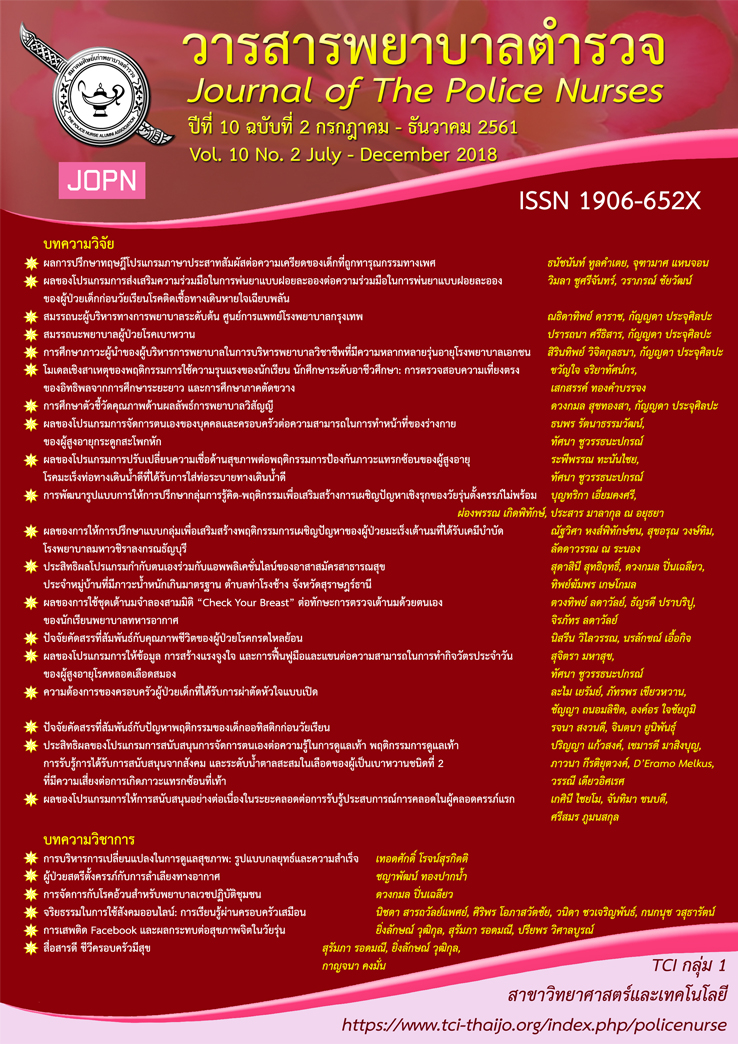ประสิทธิผลของโปรแกรมการสนับสนุนการจัดการตนเองต่อความรู้ในการดูแลเท้า พฤติกรรมการดูแลเท้า การรับรู้การได้รับการสนับสนุนจากสังคม และระดับน้ำตาลสะสมในเลือดของผู้เป็นเบาหวานชนิดที่ 2 ที่มีความเสี่ยงต่อการเกิดภาวะแทรกซ้อนที่เท้า
บทคัดย่อ
พฤติกรรมการดูแลเท้าของผู้เป็นเบาหวานมีความสำคัญอย่างยิ่งต่อการป้องกันการเกิดภาวะแทรกซ้อนที่เท้า แต่พบว่าผู้เป็นเบาหวานจำนวนมากมีพฤติกรรมการดูแลเท้าที่ไม่ถูกต้อง ดังนั้น การวิจัยครั้งนี้เป็นการวิจัยกึ่งทดลองแบ่งเป็นช่วงเวลา เพื่อศึกษาประสิทธิผลของโปรแกรมการสนับสนุนการจัดการตนเองต่อความรู้ในการดูแลเท้า พฤติกรรมการดูแลเท้า การรับรู้การได้รับการสนับสนุนจากสังคม และระดับน้ำตาลสะสมในเลือด ของผู้เป็นเบาหวานชนิดที่ 2 ที่มีความเสี่ยงต่ำต่อการเกิดภาวะแทรกซ้อนที่เท้า ตัวอย่าง ได้แก่ ผู้เป็นเบาหวานที่มารับบริการตรวจรักษา ณ หน่วยคลินิกเบาหวาน แผนกอายุรกรรม โรงพยาบาลตำรวจ จำนวน 42 ราย คัดเลือกตัวอย่างตามคุณสมบัติที่กำหนดและวิธีการสุ่มแบบง่าย โปรแกรมการสนับสนุนการจัดการตนเองในงานวิจัยนี้ ผู้วิจัยได้พัฒนาขึ้น จากการประยุกต์ทฤษฎีการจัดการตนเองของไรอันและซาวิน (Ryan & Sawin, 2009) และการทบทวนวรรณกรรมที่เกี่ยวข้อง โดยมีทั้งหมด 4 สัปดาห์ เครื่องมือที่ใช้ในการวิจัย ประกอบด้วย แบบสอบถามความรู้เรื่องการดูแลเท้า แบบสอบถามพฤติกรรมการดูแลเท้า แบบสอบถามการรับรู้ของผู้เป็นเบาหวานจาการได้รับความช่วยเหลือหรือสนับสนุนจากสังคม และผลการตรวจระดับน้ำตาลสะสมในเลือด โดยดำเนินการเก็บรวบรวมข้อมูล ก่อนให้โปรแกรม ในครั้งที่ 1 ที่ 4 สัปดาห์ก่อนให้โปรแกรม และครั้งที่ 2 ก่อนเริ่มให้โปรแกรม และหลังให้โปรแกรม ในครั้งที่ 3 ทันทีหลังให้โปรแกรมเสร็จสิ้น และครั้งที่ 4 ที่สัปดาห์ที่ 9 หลังจากสิ้นสุดการให้โปรแกรม แต่เฉพาะค่าระดับน้ำตาลสะสมในเลือดเท่านั้นที่เก็บข้อมูลในครั้งที่ 1 และ ครั้งที่ 4 วิเคราะห์ข้อมูลโดยใช้สถิติพรรณนา repeated measure MANOVA และสถิติทดสอบที
ผลการศึกษาพบว่า ตัวแปรที่ศึกษาได้แก่ ความรู้ในการดูแลเท้า พฤติกรรมการดูแลเท้า การรับรู้การได้รับการสนับสนุนจากสังคม และระดับน้ำตาลสะสมในเลือด มีความแตกต่างกันอย่างมีนัยสำคัญทางสถิติระหว่างก่อนให้โปรแกรมและหลังให้โปรแกรม (F(9,394)=8.39, p < .001) และในขณะเดียวกันค่าระดับน้ำตาลสะสมในเลือดลดลงจากร้อยละ 8.1 ก่อนให้โปรแกรม เป็นร้อยละ 7.4 หลังให้โปรแกรม ผลการวิจัยครั้งนี้ ชี้ให้เห็นว่าประสิทธิผลของโปรแกรมการสนับสนุนการจัดการตนเอง ทำให้ผู้เป็นเบาหวานนั้นมีความรู้ความเข้าใจมากขึ้นและมีการปรับเปลี่ยนความเชื่อในการจัดการดูแลตนเองในด้านการคุมระดับน้ำตาลในเลือดและการดูแลเท้า และในขณะเดียวกันผู้เป็นเบาหวานได้รับการส่งเสริมหรือช่วยเหลือสนับสนุนในการจัดการดูแลตนเองจากสังคม สิ่งเหล่านี้ย่อมส่งผลให้ผู้เป็นเบาหวานนั้นมีความมั่นใจในการกำกับตนเองให้มีพฤติกรรมการคุมระดับน้ำตาลในเลือดและการดูแลเท้าอย่างสม่ำเสมอ จนนำไปสู่การปรับเปลี่ยนพฤติกรรมดังกล่าวอย่างคงทนและถาวร ซึ่งส่งผลต่อการป้องกันและชลอการเกิดภาวะแทรกซ้อนที่เท้าและการมีสุขภาพเท้าที่ดีตลอดไป
Downloads
เอกสารอ้างอิง
American Diabetes Association [ADA]. (2013). Standards of medical care in diabetes. Diabetes Care, 36 (suppl 1), S1-S110.
Bell, R. A., Arcury, T. A., Snively, B. M., Smith, S. L., Stafford, J. M., Dohanish, R., & Quandt, S. A. (2005). Diabetes foot self-care practices in a rural triethnic population. Diabetes Educ, 31(1), 75-83.
Burn, N., & Grove, S. K. (2005). The practice of nursing research: Conduct, critique, utilization (5th ed.). Philadelphia: Elsevier’s Health Sciences Right Department.
Caliskan, D., Ozdemir, O., Ocaktan, E., & Idil, A. (2006). Evaluation of awareness of diabetes mellitus and associated factors in four health center areas. Patient Educ, 62(1), 142-147.
Centers for Disease Control and Prevention (CDC). (2014). What podiatrists would like team members to know about foot health and diabetes. Retrieved from http://www.cdc.gov/diabetes/ ndep/pdfs/ppod-guide-podiatrists.pdf
Cohen, J. (1988). Statistical power analysis for the behavioral sciences (2nd ed.). Hillsdale, NJ: Erlbaum.
Desalu, O. O., Salawu, F. K., Jimoh, A. K., Adekoya, A. O., Busari, O. A., & Olokoba, A. B. (2011). Diabetic foot care: Self-reported knowledge and practice among patients attending three tertiary hospital in Nigeria. Ghana Medical Journal, 45(2), 60-65.
Funnell, M. M., Tang, T. S., & Anderson, R. M. (2007). From DSME to DSMS: Developing empowerment-based diabetes self-management support. Diabetes Spectrum, 20(4), 221-226.
Gondal, M., Bano, U., Moin, S., Afridi, Z., Masood, R., & Ahmed, A. (2007). Evaluation of knowledge and practices of foot care in patients with chronic type 2 diabetes mellitus. JPMI, 21(2), 104-108.
International Diabetes Federation (IDF). (2013). Diabetes in Thailand-2013. Retrieved from http://www.idf.org/membership/wp/thailand.
Jansing, P., & Phopuk, S. (2011). The results of foot screening in diabetic patients at Taphanhin Crown Prince hospital. Buddhachinaraj Medical Journal, 28(2), 163-170.
Keeratiyutawong, P. (2005). A self-management program for improving knowledge, self-care activities, quality of life, and glycosylated HbA1c in Thais with type 2 diabetes mellitus (Doctoral dissertation,Nursing). Faculty of Graduate Studies, Mahidol University, Nakhon Pathom.
Khamseh, M. E., Vatankhah, N., & Baradaran, H. R. (2007). Knowledge and practice of foot care in Iranian people with type 2diabetes. International Wound Journal, 4(4), 298-302.
Kim, H. S., Kim, N. C., & Abu, S. H. (2006). Impact of a nurse short message service intervention for patients with diabetes. Journal of Nursing Care Quality, 21(3), 266-271.
Krittiyawong, S., Ngarmukos, C., Benjasuratwong, Y., Rawdaree, P., Leelawatana, R., Kosachunhanun, N., …, Bunnag, P. (2006). Thailand diabetes registry project: Prevalence and risk factors associated with lower extremity amputation in Thai diabetics. Journal of Medical Association Thailand, 89(suppl 1), S43-S48.
Kurniawan, T., & Petpichetchian, W. (2011). Case study: Evidence-based interventions enhancing diabetic foot care behaviors among hospitalized DM patients. Nurse Media Journal of Nursing, 1(1), 43-53.
Nagelkerk, J., Reick, K., & Meengs, L. (2006). Perceived barriers and effective strategies to diabetes self-management. Journal of Advanced Nursing, 54(2), 151-158.
Naicker, A. S., Ohnmar, H., Choon, S. K., Yee, K. L. C., Naicker, M. S., Das, S., & Roohi, S. A. (2009). A study of risk factors associated with diabetic foot, knowledge and practice of foot care among diabetic patients. International Medical Journal, 16(3), 189-193.
National Institute of Health and Clinical Excellence (NICE). (2004). Clinical guideline 10: Type 2 diabetes: Management of foot problems. Retrieved from http://www.nice.org.uk/ nicemedia/live/1093/29241/29241.pdf
Navicharern, R. (2012). Diabetes self-management, fasting blood sugar and quality of life among type 2 diabetic patients with foot ulcers. Journal of Medical Association Thailand, 9(2), 156-162.
Pereira, D. A., Costa, N. M., Sousa, A. L., Jardim, P. C., & Zanini, C. R. (2012). The effect of educational intervention on the disease knowledge of diabetes mellitus patients. Revista Latino-Americana de Enfermagem, 20(3), 478-485.
Rad, G. S., Bakht, L. A., & Mohebi, S. (2013). Importance of social support in diabetes care. Journal of Education and Health Promotion, 2(62), 1-25.
Rocha, R. M., Zanetti, M. L., & Santos, M. A. (2009). Behavior and knowledge: Basis for prevention of diabetic foot. Acta Paul Enferm, 22(1), 17-23.
Rosland, A., Kieffer, E., Israel, B., Cofield, M., Palmisano, G., Sinco, B., …, Heisler, M. (2008). When is social support important? The association of family support and professional support with specific diabetes self-management behaviors. Journal of General Internal Medicine, 23(12), 1992-1999.
Routley, V. M. (2011). The emerging epidemic of type 2 diabetes: An Asian Pacific perspective. On The Risk, 27(3), 72-76.
Ruangroj, P. (2009). Predictors of foot status among persons with diabetes mellitus at Police General Hospital (Master’s thesis, Adult Nursing). Faculty of Nursing, Burapha University, Chonburi.
Ryan, P., & Sawin, K. J. (2009). The individual and family self-management theory: Background and perspectives on context, process, and outcomes. Nursing Outlook, 57(4), 217-225.
Sae-Sia, W., Maneewat, K., & Kurniawan, T. (2013). Effect of a self-management support program on diabetic foot care behaviors. International Journal of Research in Nursing, 4(1), 14-21.
Sriwijitkamol, A., Moungngern, Y., & Vannaseang, S. (2011). Assessment and prevalences of diabetic complications in 722 Thai type 2 diabetes patients. Journal of the Medical Association of Thailand, 94(suppl 1), S168-S174.
Tang, T. S., Funnell, M. M., Noorulla, S., Oh, M., & Brown, M. B. (2011). Sustaining short-term improvements over the long-term: Results from a 2-year diabetes self-management support [DSMS] intervention. Diabetes Research and Clinical Practice, 95(1), 85-92.
Tsao, T. (2008). Diabetic foot care. In A. Nather (Ed.), Diabetic foot problem (pp. 503-526). Singapore: World Scientific.
ดาวน์โหลด
เผยแพร่แล้ว
รูปแบบการอ้างอิง
ฉบับ
ประเภทบทความ
สัญญาอนุญาต
ผลงานที่ได้ตีพิมพ์แล้วจะเป็นลิขสิทธิ์ของวารสารพยาบาลตำรวจ















